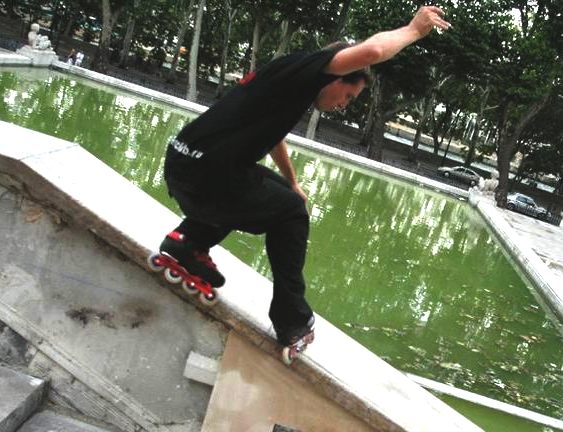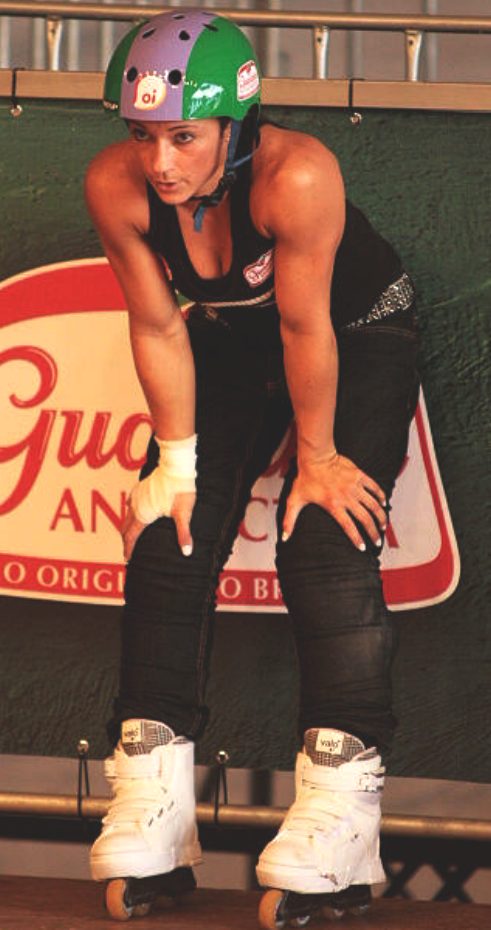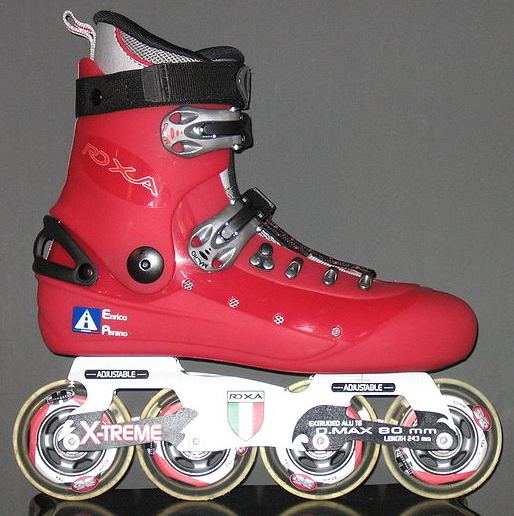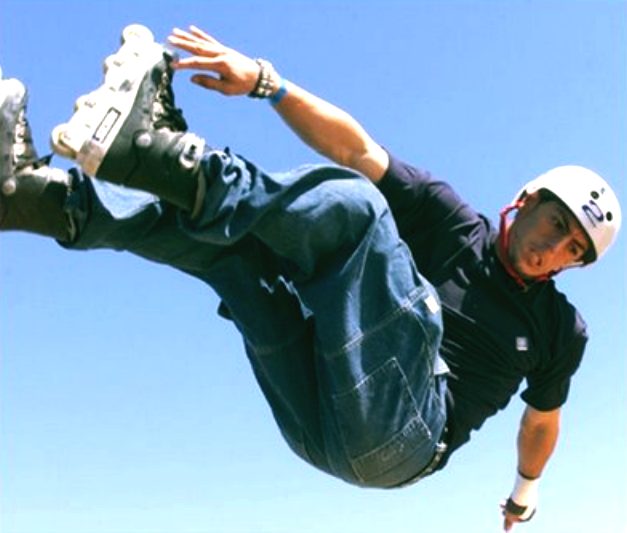|
Aggressive Inline Skating is a form of inline skating, performed on specially designed inline skates with focus on sliding stances known as grinds with a focus on new tricks, stunts and personal style. Participants refer to the activity as rollerblading, "blading", "skating" or "rolling". Vert or park is part of extreme sports and street skating or freeskate in urban areas.
Aggressive skating tricks can be performed on street obstacles or on ramps. Street skaters perform more grinds and slides, whereas ramp skaters have more air-time and therefore can perform other, often acrobatic tricks. Aggressive skaters can perform grinds by using the frames and plastic plates on the bottom of the skate. Grinds are usually done on rails and ledges although they can be performed on any obstacle which slides such as a curb or even chains. Similar to grinding, a cess slide involves sliding on the sides of the skate so the wheels aren't touching the ground, and can be performed on any surface that will allow for sliding.
Since 1994 the sport has been chronicled in various inline skating films.

HISTORY
In 1980 a group of ice hockey players in Minnesota were looking for a way to practice during the
summer. Scott and Brennan Olson formed the company Rollerblade, Inc., to sell skates with four polyurethane wheels arranged in a straight line on the bottom of a padded
boot. In 1988, Rollerblade introduced the first aggressive inline skate, the Rollerblade Lightning TRS. Aggressive inline skating finally developed as an organized sport in the early
1990s. The Aggressive Skaters Association (ASA) was formed by a number of aggressive inline skaters in 1994 as a forum to develop rules governing competitions and
equipment. The sport was included in the first X-Games in 1995 and included vertical ramp and street event
competitions. It reached its height in popularity in the late 90s, with mainstream movies like Disney's Brink! and other films. The "Senate" brand, run by Arlo Eisenberg, was very popular during the 1990s.
Founded by company owners/skating legends Brian Shima, Jon Julio and Kato Mateu and supported by all major skate companies, the World Rolling Series (WRS) links together the best skaters, event organizers, retailers and skate parks and aims to "create a tighter knit community, increase overall awareness and set a higher standard for aggressive rollerblading". The WRS circuit started in 2009 with 10 established professional contests in France, Netherlands, England, Spain, Australia and the United States. In 2012, WRS now includes 100+ Amateurs and Professional events categorized from 1 to 5 stars in over 20 countries.
Aggressive inline skating was removed from the ESPN X-Games in 2005 although it is still included in the Asian X Games, LG Action Sports Competitions, Montpellier Fise, and many other large competitions, some associated with WRS, some
not.
Brian Aragon and Chris Haffey are generally considered the current "superstars" of the sport, with many competition titles and signature skates, alongside other riders like Jon Julio, Jeff Stockwell, Alex Broskow, Richie Eisler, Montre Livingston, Mike "Murda" Johnson, CJ Wellsmore, Franky Morales, Chris Farmer, Dustin Latimer, Soichiro Kanashima, Eito Yasutoko, Julian Bah, Takeshi Yasutoko, Roman Abrate, Mathieu Ledoux, Billy O'Neill, James Mandato and many more. They are all professional skaters who have been sponsored by prominent skate brands. Fabiola da Silva is one of the few prominent female
riders.
Current aggressive inline skate manufacturers include Valo, Xsjado, Remz, USD, Rollerblade, K2, SSM, Razors and Adapt Brand.
TYPE
Street
In street skating, also known as freestyle skating, the skater performs tricks by utilizing features existing in a common, everyday
environment. This involves skaters grinding hand rails and concrete ledges, jumping stairs, ramping off of embankments and generally turning anything on the regular street into an obstacle, ramp, or grind
rail. Creativity is often seen as an important aspect of street skating, since skaters are able to invent or link tricks specific to a unique environment, rather than performing more standard maneuvers on predefined obstacles as in park and vert skating.
Park
Park skating refers to skating that occurs in various private and community
skate parks. This style differs from street skating due to the specific nature of skate parks, which are designed for skaters to do tricks, e.g. on the top of the ramp (coping). Park skating often emphasizes the technical side of aggressive inline, focusing on the variety of tricks a skater can do and encouraging skaters to connect tricks. A series of tricks connected together in a fluid motion over different obstacles is known as a 'line'. Skate parks often feature quarter pipes and half-pipes, curved ramps and other features that are not usually found in a regular urban setting. A better quality skate park will have good lines—making it easier for skaters to perform tricks. Good
skate parks have a flow to them.
Vert
Vert, short for vertical, skating is a style of skating performed within a
half-pipe. It focuses on complicated aerial maneuvers, such as spins and flips. The intent of the skater is to build speed until they are of sufficient height above the edge of the ramp to perform various aerial
acrobatics. They may also grind the lip of the half-pipe sliding their skates from one point of the lip to another. In competitions skaters have limited time, often less than a minute, to impress the judges by landing numerous and difficult
tricks.
Powerblading
Power-blading refers to a relatively new variation on roller-blading that combines elements and technologies of both aggressive and
free-skating, with an emphasis on using urban environments creatively and at speed.
"Power-blade" is a generic name for the style of inline skate used, based on aggressive boots but with larger frames and often riding a flat set-up of eight wheels, instead of the anti-rocker or freestyle frames more common in pure aggressive skating.
Power-bladings adds grinds to free-skating. Or other way around – it incorporates speed and freedom of
free-skating in to aggressive blading.

SKATE
DESCRIPTION Frames
The chassis of the skate, called the frame, bolts to the bottom of the skate. Skaters grind on the frames, which are designed for this purpose.
There are several different variations on frame design. Originally a skate had four wheels on each skate, with a gap between the middle wheel where a plastic insert called an H-block was used for grinding. During earlier times, a plastic plate, known as the 'grind plate' was attached to the frame on the outside of the two middle wheels instead of an H-block. This allowed normal recreational skates to be converted into aggressive skates, and it was how most aggressive skates were built at the time. On aggressive skates with H-blocks, the grind plate could be used to increase the life of the H-block. But as frame manufacturers began making removable H-blocks, the grind plate fell out of favor. As the sport evolved, skate companies started manufacturing wheels that were intentionally hard and undersized, in order to facilitate grinding. The undersized wheels are called anti-rockers, and replace the two middle wheels.
Generally, there are three different types of modern frames: Flat, Anti-Rocker, and Freestyle. Flat, as described above, means you have four wheels per skate. There is another variation of this called the Hi-Lo setup. This means it has large outer wheels, but small inner wheels to make grinding easy. The inner wheels' axles are closer to the ground so that all the wheels touch the ground.
Anti-Rocker, as also described above, is the most popular setup. Freestyle frames have no inner wheels, giving the user a large amount of space in the middle for grinding. Another setup that's gaining popularity, called tri-rocker, means that there are three wheels per skate. The remaining axle hole is left empty or replaced with an anti-rocker wheel. This combines the benefits of a flat setup (going fast and turning easily) with the benefits of an anti-rocker/freestyle setup (grinding easily). The frame company Create Originals makes frames that are meant for tri rocker to be a possibility.
In the late 1990s, the Universal Frame System (UFS) was introduced by frame manufacturers to allow the user to easily customize their
skates. This led to increased customization of skates within the sport by allowing the user interchangeability between different company's
frames. Today, all major frame and skate manufacturers support UFS.
Wheels
Modern skate wheels have undergone many years of development and iteration. The development of the main material, polyurethane (usually simply called urethane), has been dependent on advancements in the polymer industry. The balance between hardness and grip is the key to an optimum skate wheel. Aggressive skate wheels are usually between 54 and 60mm, while anti-rocker wheels are between 40 and 47mm.
Anti-rocker wheels
Two high density polyurethane or plastic wheels with high hardness between 40 and 47mm, replacing the inner two wheels. Some skaters prefer replacing only one of the inner wheels with anti-rockers (called tri-rocker). Anti-rocker wheels enable skaters to grind obstacles with a relatively high diameter. These wheels, unlike normal wheels, give skaters a relatively large margin of balance error while grinding on a concrete curb or ledge. While normal wheels get stuck on concrete surfaces, the much harder anti-rocker wheels will simply slide because of the friction being less, allowing skaters to lean out of their center of balance without tripping. Some people prefer a four wheel setup because grinds must be done perfectly to succeed.
ROLLER
BLADING Aggressive skating is referred to by participants as
roller-blading, blading, skating or rolling and includes a variety of grinds, airs, slides and other advanced skating maneuvers. Types of aggressive skating include Park, Vert and Street.
Park skating refers to doing tricks within a skatepark. Street skating specifically refers to tricks performed on non-allocated obstacles (i.e. not skate parks). Vert skating involves doing airs and tricks while in the air such as flips, on a large halfpipe known as a vert ramp.
There are three major types of aggressive inline skates: hard boots, soft boots, and skeletal skates. Hard boots are very rigid and often heavy compared to speed skates and recreational skates. Soft boots offer more flexibility and comfort than hard boots, and are extremely light. However, they are not very durable. Skeletal skates are mostly produced by the company Xsjado, and use a system similar to snowboard bindings. Specially designed shoes called footwraps are worn inside of skeletal skates.
Aggressive inline skates can also be fitted with small, hard, plastic wheels, used in place of the two middle wheels. These small wheels, or "anti-rockers," are used to help lock onto a ledge or rail when grinding. Anti-rockers allow a larger split between the 2nd and 3rd wheels, allowing a skater to more easily grind wider objects. While some prefer a flat wheel setup, in this case meaning all 8 wheels touching the ground, others find it limiting due to the body control needed to assume a lower center of gravity so as to avoid the 2nd and 3rd wheels, made of urethane, touching the grinding surface. Anti-rockers are usually made of Nylon, or a substantially harder urethane than normal wheels, which means if a skater were to catch either of their center wheels on the grinding surface, they are less likely to be slowed or halted by friction between the wheel and rail or ledge. Anti-rockers are also useful when rolling over a hump or down a roll-in, where the center wheels in a flat setup can cause an unstable rocking of the skate due to the short wheel base, and is where the term 'anti-rocker' originated.
Aggressive inline saw a sharp decline in the late 1990s, but during 2000-2003 found a major resurgence for the sport when street skating became increasingly popular. At this time professional skaters including Brian Shima, Franky Morales, Chris Haffey, Dre Powell, Brian Aragon and Aaron Feinberg, among others were pushing unseen boundaries in performing seemingly impossible and dangerous stunts in mostly street settings. In addition, the IMYTA (I Match Your Trick Association) provided a venue for skaters to demonstrate these tricks. The IMYTA held contests at a street location and the skaters would have to match each trick in the first round of skating or be eliminated. The progression continued with the pool of skaters dwindling and more dangerous and difficult tricks would then be performed and a winner declared. Competitions such as the IMYTA encouraged skaters from many different countries to set up their own local real street competitions. Sadly, the IMYTA series grew too large and was riddled with legal difficulties when several hundred to a thousand inline skaters would show up to a contest, drawing a strong interest from local law enforcement officers wanting to see permits.
Founded by company owners/skating legends Brian Shima, Jon Julio and Kato Mateu and supported by all major skate companies, the World Rolling Series (WRS) links together the best skaters, event organizers, retailers and skate parks and aims to "create a tighter knit community, increase overall awareness and set a higher standard for aggressive rollerblading". The WRS circuit started in 2009 with 10 established professional contests in France, Netherlands, England, Spain, Australia and the United States. In 2012, WRS now includes 100+ Amateurs and Professional events categorized from 1 to 5 stars in over 20 countries.
Aggressive inline skating was removed from the ESPN X-Games in 2005 although it is still included in the Asian X Games, LG Action Sports Competitions, Montpellier Fise, and many other large competitions, some associated with WRS, some
not.
Brian Aragon and Chris Haffey are generally considered the current "superstars" of the sport, with many competition titles and signature skates, alongside other riders like John Julio, Jeff Stockwell, Montre Livingston, Mike "Murda" Johnson, CJ Wellsmore, Franky Morales, Chris Farmer, Dustin Latimer, Soichiro Kanashima, Eito Yasutoko, Julian Bah, Takeshi Yasutoko, Roman Abrate, Mathieu Ledoux, Billy O'Niell, James Mandato and many more. They are all professional skaters who have been sponsored by prominent skate brands. Fabiola da Silva is one of the few prominent female
riders.
Current aggressive inline skate manufacturers include Valo, Xsjado, Remz, USD, Rollerblade, Valo, K2, SSM, Razors and
Nimh.

LINKS
and REFERENCE
Skate
manufacturers:
Retail
stores:
Print/Online
media:
Other
links:
Inline
Skating Club links:

A
- Z SPORTS INDEX
|
Ski
the Eiger
- Youtube
|
Skiing
accident - Youtube
|
|
Ski
lessons carving - Youtube
|
Intermediate
skiing
- Youtube
|

A
taste for adventure

A
heartwarming adventure: Pirate
whalers V Conservationists
with
a £Billion dollars riding on the conclusion
|



